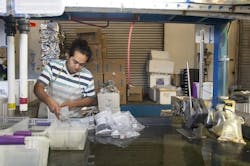About the author: Meredith Flynn is director of marketing for NuWater USA. Flynn can be reached at [email protected] or 415.464.1909.
When you think about all of the cargo flying in and out of an airport on a daily basis, passengers’ luggage and ordinary mailed packages might come to mind—but certainly one of the last things you might consider is tropical fish.
At Los Angeles International Airport (LAX), fish transport is part of everyday business, thanks, in part, to Sea Dwelling Creatures, a marine fish wholesaler located in Los Angeles. The company, owned by brothers Scott and Brad Cohen, ships 700 to 800 boxes of fish per day, each containing up to 20 fish.
Conveniently located a few blocks from LAX, Sea Dwelling Creatures commonly acts as the middleman, taking receipt of exotic tropical fish flown in from Fiji and Australia and providing them with a much-needed respite before they continue on their journey to aquariums, zoos and pet shops across the U.S.
Specialized Treatment
Aside from the creatures themselves, the most important component of Sea Dwelling Creatures’ business is, of course, water. A quick glance into the company’s 25,000-sq-ft facility reveals rows of tanks and aquariums as far as the eye can see. More than 130,000 gal of holding water are required to house a variety of sea creatures ranging from tropical fish to invertebrates like starfish to an array of special corals. An additional 5,000 gal of water is delivered via truck six days a week.
Before all of this water is distributed throughout the facility, it undergoes rigorous filtration. Scott, founder of the company, has spent the past 24 years perfecting the art of water filtration to ensure the highest survival rate for the fish.
Even though the water is treated with ozone and ultraviolet (UV) and enriched with calcium before it even reaches the facility, Scott runs it through ozone and UV treatment a second and third time before it is divided and filtered differently according to its intended application.
Corals require different water quality than fish, and careful considerations are taken throughout the facility to prevent the two types of water from mixing. The water used in the fish aquariums has a lower salinity then the water used in the coral aquariums; the coral water also is enriched with a variety of essential elements, such as calcium, strontium, potassium and magnesium.
Further Filtration
In 2011, Scott sought the expertise of Jim Settle and Mike Borquez of NuWater USA, a water filtration company based in Concord, Calif., to further streamline and upgrade his water treatment systems. Settle and Borquez built a custom-designed roughing filter for the facility with specially sized media to clarify the water and protect the downstream equipment. Scott found that if the media were too fine, they would blind off too quickly and clog the filter. If they were too coarse, they would not provide enough filtration. NuWater’s media is sized to provide “in-depth” filtration — conventional filter media typically only utilize the first few inches of media depth, whereas this media is designed to trap particulates much deeper into the media bed.
Additionally, Settle and Borquez designed a system of tanks with organic scavenging polyacrylic ion exchange resin (NuWater USA resin RSBA10) to capture organic species with a high resistance to fouling. This type of resin has a hydrophilic structure, which means it has a lower capacity but is effective for removing organics. It also offers a greater reversible removal of organics on regeneration, and therefore can cope with higher levels of dissolved organics.
These resins are loaded into a softener tank fitted with a self-regeneration head with brine injection and a solenoid ion exchange resin to eliminate organics from the aquarium’s water supply. The tanks are fitted with a valve that closes whenever the system goes into backwash or regeneration, preventing the flow from going back into the aquariums.
Scott has seen a substantial improvement in his water’s oxidation-reduction potential as a result of using the organic scavenging resin — as much as 50 to 60 millivolts, which equals about a 25% efficiency improvement. As a result, all of the sea-dwelling creatures benefit from a reduced potential for disease — from the tiniest cleaner shrimp to the 400-lb groupers.
Download: Here
